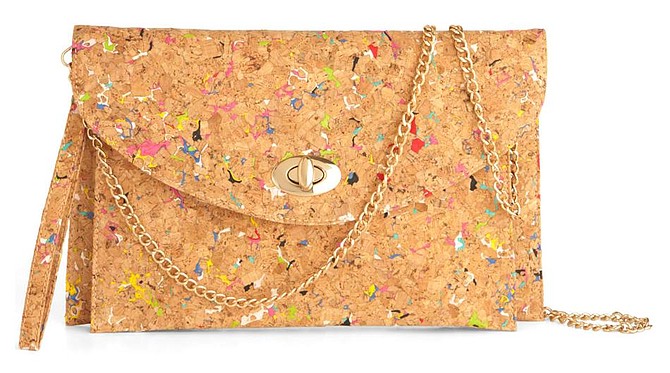Cork Surges in Fashion Industry as it Pops Up in Accessories
Cork. It’s not just for wine stoppers and bulletin boards anymore.
It was embraced by some progressive furniture makers decades ago and is a staple in housewares, but cork has found a larger place among shoes, handbags, jewelry and other fashion accessories.
Designer Elaine Turner is a proponent of cork, which is renewable, feather light and water-resistant. So is Ingrid Heinkel, who imports cork accessories like wallets and a backpack in a tiger-stripe design.
Cork is popping up in umbrellas, simple apparel items like shawls, watchbands, bracelets, necklaces, hats, belts, golf bags and shoes, shoes, shoes — moccasins, flip-flops and Superga sneakers with neon flecks to Jimmy Choo wedges and Badgley Mischka stilettos.
And we’re not just talking soles and shock-absorbent footbeds. We’re talking uppers in double straps and gold tips from Turner and vibrant color combinations in slides, though cork is often left in its raw, recognizable state.
“I think we’re in a very natural vibe right now and a very green vibe. Cork works with that. It’s just something unique. This season it has really hit its high point,” said Alison Minton, who blogs about accessories at Accessorygeneration.
While Minton sees cork as a seasonal item for spring and summer, Heinkel went so far as to declare: “Cork is the new leather.” Farfetched? In a recent interview, she called cork in accessories an emerging market.
“I think that it’s on its way to becoming something permanent in the marketplace,” Heinkel said from Amelia Island, Florida. “I used to live in Spain, and I found the handbags on a weekend in Portugal, and I’m having a lot of fun with it."
Turner, fond of natural materials that also include raffia, started using cork about seven years ago to further her tropical vacation aesthetic.
“We started making bags and shoes out of it, and it instantly was popular. It’s probably our No. 1 material for spring every year,” she said. “It’s a neutral and very versatile.”
Turner uses a manufacturer in Spain, a part of the Mediterranean where most of the cork supply comes from.
“It’s very malleable, so it translates easily on handbags and shoes. And it’s highly durable. ... People love it for travel,” Turner said. “It’s also cost-effective.”
Although cork may be having a fashion moment, it has lost momentum elsewhere.
Ohad, who teaches at the New York School of Interior Design, said cork remains on the outskirts of forward-looking furniture after it appeared to be resurfacing a few years ago.
“You really don’t see cork being utilized in very sophisticated design in furniture,” she said.
“In the ’20s and ’30s architects discovered cork, and it was the perfect material for modernism because it was clean and it was very different. It had a very special surface to it and texture to it,” Ohad said, noting another spurt as a material in 1950s home design.
Some have likened the feel of cork to suede in fashion accessories. Patterns can be built using dark and light shades. In shoes, Minton said, the cork moment began in the wedge part of wedges, but now designers “have decided to go full-on cork.”
“It’s not heavy on the foot. It’s great for the beach. It looks good if you’re walking in the city,” she said. And it transitions well, when dolled up with metal fittings and other touches, from day to evening.
Latest Stories
- Retired Illinois Appellate Court Justice and Member of the Glen Ellyn Area Alumnae Chapter of Delta Sigma Theta Sorority, Inc. Shelvin Louise Marie Hall Dies
- It’s That Time Again: Reviewing Your Medicare Plan Before It’s Too Late
- Exciting Breakthroughs in Alzheimer’s Research Offer New Hope for Patients
- C3 Impact Fund Seeks To Spur Growth In Underserved Communities Through Real estate
- HelloBaby Identifies Site For A Second Location
Latest Podcast
Quandra-Urban Market Exchange

